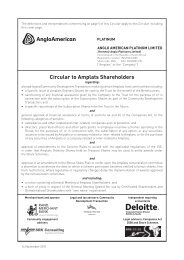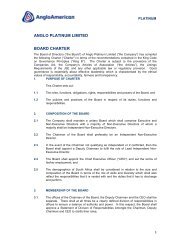construction process), no adequate, independent mechanism wasput in place for the impartial management of disputes and conflictrelating to the Motlhotlo relocation process. In the draft RAP (2004),mention is made of bringing in ‘external expertise’ but only in seriouscases. Ideally, this would include external mediation, an ombudsmanor another independent process.In spite of the high level of conflict experienced as a result of therelocation, there are no records of such a party being approachedfor assistance. Instead, grievances which were not easily addressedby the assistant project managers were referred to the ExecutiveCommittee (ExCo) of the Project for resolution ( 2 ) . Given that themembers of the ExCo were, in some instances, at the heart ofthe concerns raised by community members, this forum has notprovided for the impartial management of disputes required underthe IFC Performance Standards.This is considered a critical flaw in the Motlhotlo relocation. In theabsence of an independent mediation process, some communitymembers chose protest as a vehicle for voicing their concerns,others joined resistance groups, and still others chose representationof external lawyers – all of which, it could be argued, result fromthe fundamental failure of the grievance mechanism to adequatelyaddress community concerns about the relocation process.Understanding the Psycho-Social Impacts of ResettlementIn its dealings with the relocated communities, AP seems tohave failed to sufficiently acknowledge or address the potentialemotional, cultural or psycho-social impacts of the resettlement.These are the intangible, qualitative social effects of displacementwhich stem from the upheaval associated with the loss of land,home and sense of place and community, as well as the long termdamage to social cohesion through conflict and divisions whichoccurred.The issue is therefore not just about the quality/size of thereplacement structures and services, and the compensationamounts provided, but equally about whether or not the full extentof the community’s loss was truly appreciated and respected. Wherethe resettlement process has allegedly undermined the communityfabric and traditional structures, or where the emotional impacts ofresettlement has been difficult to bear, this appears never to havebeen openly acknowledged and addressed by AP.In spite of AP’s efforts around consultation, the ultimate failureof established structures to provide a mouth piece for suchconcerns and grievances meant that many people were denied anopportunity to voice and address the deeper, more emotional andpsycho-social impacts of resettlement. Solutions for these impacts2 The Exco is made up of senior representatives from the sponsor andthe two S21 Companies, represented by their legal representatives and twoex-officio project managers, namely, Greg Morris and Nalen Padayachee.aren’t easy to come by, but at a basic level, they start with lines ofopen communication and trusting relationships, both between andwithin communities, and between AP and the affected residents.B.3.3 Effectiveness of the Consultation ProcessIn addition to the key strengths and weaknesses listed above,the review highlighted several key themes with respect to theconsultation process. These include questions on:• the effectiveness and inclusivity of the consultation processes;• the outcomes associated with disclosure of information; and• the inclusivity and cultural appropriateness of the process.The strengths and weaknesses associated with AP’s approach toconsultation are described below.Efforts Made Towards Effective and Inclusive ConsultationThe key strengths in AP’s approach to consultation are evident atspecific points in the resettlement process, in particular, the siteselection process, identifying eligibility and the personnel secured toprovide consultation support during the audit, compensation andconstruction process.Site selection: A review of evidence indicates that the host siteselection was driven by a consultative process, and was largelycommunity driven. AP went to considerable efforts to consult onthe available options, including bussing residents out to see theidentified farms. Evidence of a community empowered process isabundant in the fact that the communities themselves ultimatelychose a site which went against the advice of AP.Identifying eligibility: Stakeholder testimonies confirm thatAP adopted a very inclusive approach to eligibility, and that allhomesteads, regardless of land rights, were included in the auditand compensation process. This is evident in AP’s inclusion of theadditional structures erected by a sector of the youth in order toclaim compensation. This was done in spite of advice from theInduna and members of the community to ignore their claims.Appointment of consultation personnel: As part of the overallProject Management Team, AP appointed a number of personnelto address the consultation requirements of the resettlementprocess. This included the appointment of a Community Liaison,Social Services and Dispute Resolution Management team,staffed jointly by an AP staff member and a staff member of theProject Management consultants: Hararo Project Management.Both interfaced with the communities and their representativeson community project issues, addressing social issues andresolving disputes where necessary. In anticipation of communityviii
difficulties in understanding the audit and compensation process,AP appointed the Operational Team (as previously discussed), andthen, in support of grievance management, two CLOs from eachcommunity.In spite of these efforts, it is the finding of this review that overall,the Motlhotlo consultation process falls short of IFC performancestandards for consultation, in particular with regards to therequirement for free, prior and informed consultation, and for aconsultation process that is inclusive and appropriate to affectedresidents. These weaknesses are outlined below.Consultation to be Based on Prior Disclosure of Relevant andAdequate Information, thus Enabling Informed Participation andConsentAgreement to relocateConcerns around free, prior and informed consultation go as farback as the community agreement to relocate in 1992. Althoughthe decision to relocate was a negotiated process, involving theMapela Tribal Authority (MTA) and the community appointed RSCs,and culminating in a community resolution to relocate, concernshave emerged as to whether this was done with a full understandingof the implications of this decision. The Municipality commentedthat the communities could never have understood the scale ofthe resettlement in terms of the impacts on their lives, when firstpresented with the idea. A hope for a better quality of life andfinancial reward may have overshadowed any possibility of criticalthinking about what it meant to resettle.In this regard, it is unclear whether the Kgoshigadi was either willingor had sufficient knowledge to be able to facilitate discussionsand raise awareness among community residents on the potentialnegative impacts of resettlement. ERM are also uncertain regardingthe extent to which AP raised awareness about the negativeimpacts of resettlement, based on their recent experience with GaPila. Typically, an EIA should provide an education function in thisregard. However, the timing of the EIA (starting in September 2002)meant that the findings of the impact assessment and associatedidentification of the impacts of resettlement were not fed back to thecommunity residents in time to inform their decision to move (firsttaken in October 2002). The extent to which informed consent wasfully given to the relocation is thus uncertain.Weaknesses in the audit and compensation processIn spite of the successes of some parts of the audit andcompensation process, concerns remain regarding the extentto which people fully understood the audit and associatedcompensation process. This is certainly reflected in the frequentlyheard claim among community respondents that ‘they didn’t knowwhat they were signing’ (in reference to the signing off on auditfindings). In fact, the perception that AP exploited the illiterateand those with a lack of educational capacity to understand thecompensation process, is at the root of many of the allegations madeby certain of the community residents and resistance groups towardAP. Notwithstanding these allegations, it is recognised that extensiveefforts were made by AP, and within a challenging context of highlevels of illiteracyBoth the Project Management Team and the construction contractoridentified illiteracy of community residents and competency of theOperational and Community Relations Teams as major obstaclesin the translation of the results of the household audits into houseplans. This resulted in unmanaged expectations around how theplans translated into built physical structures. These expectationsresulted in disappointment, frustration and even resistance.These misunderstandings and unmet expectations could perhapshave been avoided with better community education priorto starting the audit, and by the use of community relations/communications specialists in roles that were being filled by nonsocialspecialists, (i.e., architects, engineers, quantity surveyors, localresidents etc). Feedback received from the construction contractorwas that the Operational Team and the Community Relations Teamstruggled to translate the technical information relevant to theaudit and compensation process into a form understandable for thecommunity residents.Given the widespread illiteracy and low levels of education in thesecommunities, ERM are of the opinion that a more systematic preeducationprogramme for the Operational Team, the CommunityRelations Team, and the community should have been considered,facilitated by the required social specialists.Effectiveness of the S21sThe consultative and participatory approach adopted by APwas undermined by the fact that the main vehicle used forcommunication (i.e., the S21) was not appropriate or effective inensuring adequate disclosure of information to the majority ofcommunity residents they were elected to represent. The reasonsfor this failure would appear to be due to the S21s’ reported poorperformance as a consultative body, linked in part, to an apparentlack of capacity amongst its members.In spite of the S21’s intended role as a feedback mechanism, it hasbeen widely criticised for its failure to serve as an accountable,consultative and transparent communication structure.Conversations held with community respondents, the communitylegal advisors and the construction contractors indicate that theix
- Page 1: ENVIRONMENTAL RESOURCES MANAGEMENTR
- Page 5: ContentsGlossaryA Ga Pila Executive
- Page 9 and 10: A: EXECUTIVE SUMMARYA.1 INTRODUCTIO
- Page 11 and 12: The GRMT committee was transformed
- Page 13 and 14: appointed by AP (in consultation wi
- Page 15 and 16: Consultation during the AuditThe st
- Page 17 and 18: Lack of Monitoring and Corrective A
- Page 19 and 20: process. This does not appear to ha
- Page 22 and 23: IFCPerformanceStandard &Section (#)
- Page 24 and 25: IFCPerformanceStandard &Section (#)
- Page 26 and 27: B.2 KEY EVENTS IN THE RESETTLEMENT
- Page 28 and 29: Compensation for Loss of AssetsMuch
- Page 30 and 31: During the review, ERM had sight of
- Page 34 and 35: S21’s failure to report back effe
- Page 36 and 37: IFCPerformanceStandard &Section (#)
- Page 38 and 39: IFCPerformanceStandard &Section (#)
- Page 41 and 42: C: EXECUTIVE SUMMARYLOOKING FORWARD
- Page 43: implementation of any such interven
- Page 47 and 48: PART ONEIntroduction to the Resettl
- Page 49 and 50: It should be noted that the IFC Per
- Page 51 and 52: A faction of the community at Sterk
- Page 53 and 54: The voice of those community member
- Page 55 and 56: Government Role-playersThe Governme
- Page 57: ENVIRONMENTAL RESOURCES MANAGEMENTL
- Page 61 and 62: PART TWO Table of Contents1 Topic 1
- Page 63 and 64: TOPIC 11 Avoid or Minimise Resettle
- Page 65 and 66: TOPIC 22 Land Acquisition and Land
- Page 67 and 68: Documentation of TransactionsThe EI
- Page 69 and 70: TOPIC 33 Identifying Affected Peopl
- Page 71 and 72: Concerns around the approach to, an
- Page 73 and 74: TOPIC 44 Effective Consultation and
- Page 75 and 76: this review and therefore their rol
- Page 77 and 78: elocation is discussed further in T
- Page 79 and 80: This reaction was very surprising t
- Page 81 and 82: and compensation process to the com
- Page 83 and 84:
The question raised here is whether
- Page 85 and 86:
TOPIC 55 Compensation5.1 WHAT THE I
- Page 87 and 88:
5.2.4 Provide Compensation for All
- Page 89 and 90:
IFCPerformanceStandards andSection
- Page 91 and 92:
y some community members does seem
- Page 93 and 94:
Be Accessible at No Cost and Withou
- Page 95 and 96:
Although the communities confirmed
- Page 97 and 98:
QualityAlmost 100 percent of those
- Page 99 and 100:
Erosion of social capital and netwo
- Page 101 and 102:
The current climate, with the deep
- Page 103 and 104:
elocation processes of the time. It
- Page 105:
9.3 PERFORMANCE ASSESSMENTAn assess
- Page 108 and 109:
PART THREE Table of Contents1 Topic
- Page 111 and 112:
TOPIC 11 Avoid or Minimise Resettle
- Page 113 and 114:
TOPIC 22 Land Acquisition and Land
- Page 115 and 116:
BOX 2.1 SUMMARY OF RELOCATIONAGREEM
- Page 117 and 118:
of the official land allocation pro
- Page 119 and 120:
TOPIC 33 Identifying Affected Peopl
- Page 121 and 122:
the extent to which the homeowners
- Page 123 and 124:
TOPIC 44 Effective Consultation and
- Page 125 and 126:
community members at the kgoro woul
- Page 127 and 128:
BOX 4.1SHORT AND LONG TERMOBJECTIVE
- Page 129 and 130:
During the SIA, a total of 12 focus
- Page 131 and 132:
• Consultation to be inclusive an
- Page 133 and 134:
communities, and even examples of m
- Page 135:
4.3.3 Consultation and Resistant Co
- Page 138 and 139:
an expectation in many of the resis
- Page 140 and 141:
Kgoshigadi Langa and AP. For reason
- Page 142 and 143:
BOX 5.2OBSTACLES EXPERIENCED DURING
- Page 144 and 145:
5.3 PERFORMANCE ASSESSMENTAn assess
- Page 146 and 147:
then be taken up by the committee m
- Page 148 and 149:
Grievance Mechanism to be Scaled to
- Page 150 and 151:
IFCPerformanceStandard &Section (#)
- Page 152 and 153:
As mentioned in Topic 5: Compensati
- Page 154 and 155:
While the standard of housing has a
- Page 156 and 157:
Unfortunately, however, a lot of il
- Page 158 and 159:
Apart from the initiatives listed i
- Page 160 and 161:
that such expectations present an e
- Page 162 and 163:
TOPIC 99 Implementation Planning an
- Page 164 and 165:
9.2.2 Ensure Adequate Capacity forI
- Page 166 and 167:
9.2.3 Monitoring and EvaluationThe
- Page 169 and 170:
ENVIRONMENTAL RESOURCES MANAGEMENTL
- Page 171:
ENVIRONMENTAL RESOURCES MANAGEMENTP
- Page 174 and 175:
1.3 KEY THEMESAND ASSOCIATEDRECOMME
- Page 176 and 177:
This negotiation process is only li
- Page 178 and 179:
structure or a sub-committee which
- Page 180 and 181:
• Anglo’s SEAT process allows f
- Page 182 and 183:
decision to replace all existing en
- Page 184 and 185:
may be available (e.g., benefits fr
- Page 186 and 187:
only has limited experience of form
- Page 189 and 190:
ENVIRONMENTAL RESOURCES MANAGEMENTP
- Page 191 and 192:
In spite of these improvements, wea
- Page 193 and 194:
ENVIRONMENTAL RESOURCES MANAGEMENTA
- Page 195 and 196:
Map A1 Regional Overview Map
- Page 197 and 198:
Annexure BList of Questions for Int
- Page 199:
KEY ISSUEImprove or at Least Restor
- Page 202 and 203:
Table D1.1 Stakeholder Consultation
- Page 204 and 205:
Date and TimeStakeholderPhase ofEng
- Page 206 and 207:
Photo A1 Old Crèche at Puka Sekhao
- Page 208 and 209:
Photo A5 New Motlhotlo Village Clin
- Page 210 and 211:
Photo A12 Ga Puka small ‘addition
- Page 212 and 213:
Photo A16 Ga-Puka 115m 2 medium hou
- Page 214 and 215:
Photo A21 7.5 km tarred access road
- Page 237 and 238:
Annexure FReferences
- Page 239:
Annexure GNon Technical Executive S
- Page 242 and 243:
How the Report was ResearchedERM tr
- Page 244 and 245:
ThemeEffectiveConsultationCompensat
- Page 246 and 247:
ThemeAvoid or Minimise Resettlement
- Page 248 and 249:
ThemeImplementation, Planning,Ensur
- Page 250 and 251:
Ka moo Pego e Nyakišišitšwego ka
- Page 252 and 253:
Morero Senyakwa sa Molawana wa Pank
- Page 254 and 255:
Morero Senyakwa sa Molawana wa Pank
- Page 256 and 257:
Morero Senyakwa sa Molawana wa Pank
- Page 258 and 259:
LIST OF TABLESGa Pila Executive Sum


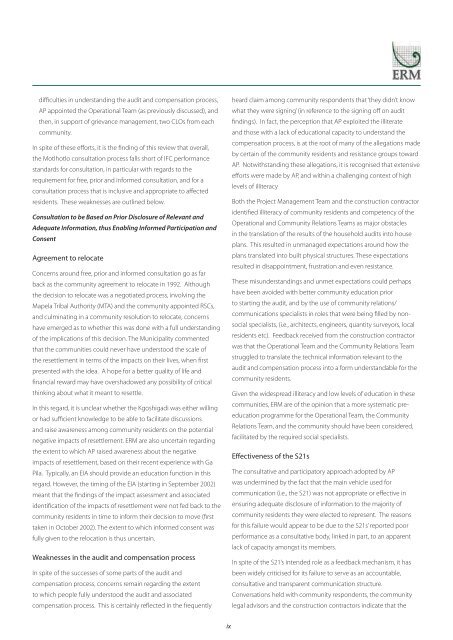
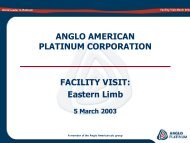
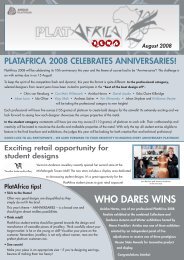
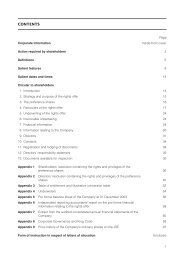

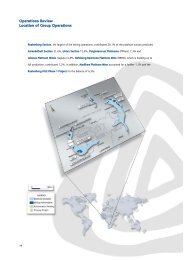



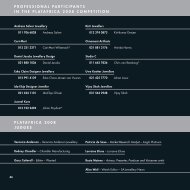
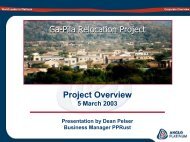

![[PDF] Mogalakwena Mine - Anglo Platinum](https://img.yumpu.com/43065142/1/184x260/pdf-mogalakwena-mine-anglo-platinum.jpg?quality=85)
